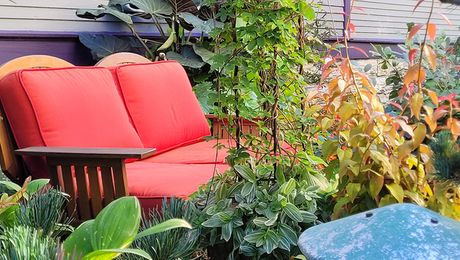
Monsoons are a welcome addition to help alleviate some of the summer heat we’ve been battling. Typically arriving in the late afternoon, monsoons can bring heavy rain, lightning, and high winds. While monsoons can be damaging to our desert landscape, they can also provide some much-needed moisture from Mother Nature. Monsoon season in the Southwest goes from mid-June to late September. These rains not only brighten up some of our wilting leaves and blooms, but they also encourage some activity from our four-legged desert friends such as the Gila monster and other reptiles that enjoy the jump in humidity.

Collect water. Water harvesting really does go hand in hand with the monsoon season. Being able to capitalize on the abundance of rain and reuse that water in your gardens is a gift. And it’s also a great savings to your water bill! These collection devices can range in size from 50 gallons to well over 2,000 gallons. The style and look you’re going for may depend on where you have the space for one. I’ve found some great options on Gardener’s Supply Company. You can also Google what’s available in your area or choose to build your own. Some cities promote water harvesting and may even provide a free or discounted tank for your personal use.

Tend to your indoor garden. Gardening outdoors right now tends to be limited to early in the morning or later in the evening when the sun is setting. During the day can be too brutal for most of us to consider the outdoors enjoyable. Instead, we love to build up our indoor collections and give them some new life. We’re always trying to add to our houseplant collection, which includes a multitude of air plants, succulents, and cacti. Plus, indoor containers act as art for us; the colors, textures, and playful shapes add a bit of whimsy. If some of your succulents are looking a bit leggy, it’s time to trim them up. Succulents become leggy or stretched out when they’re not receiving enough sunlight throughout the day, so they’re actually reaching for the light. Luckily, cutting them back is easy. Remove the lower leaves (which can be propagated) and cut the stem back, leaving about 1.5 inches to replant. Just be sure to give them two to four days of drying time before replanting. We don’t want them to absorb too much water right off the bat.

Spot-water mixed containers. Spot-watering your containers can be a key technique to understand, especially if you like to mix and match your thirsty annuals and drought-tolerant succulents and cacti as much as we do. If you have drip lines running into everything equally, you may be noticing that not all of your plants are equally as happy. The key for spot watering is a small watering can of good quality that can direct where water is being delivered in each container. It allows us to nourish the annuals while (slightly) depriving the succulents in order to keep everyone happy and perfectly watered.

Cover vulnerable plants with shade cloth. If you did add some new desert perennials to your gardens recently, be sure to protect them as needed. If you’re noticing sun burning or an abundance of leaves dropping, you may need to protect them from the harsh sun with some shade cloth. We keep rolls on hand to protect our newly planted shrubs and trees. It’s not very attractive, but it gives them more of a fighting chance in these tough summer conditions here in the Southwest. We recently added some shade cloth to our vegetable garden, and it’s really helped reduce how quickly the soil was drying out. It also allows the plants to flourish instead of stressing from the intense rays.

Be on the lookout for cochineal scale. Cochineal scale may start showing itself on your prickly pear (Opuntia spp. and cvs., Zones 3–11) and cholla (Cylindropuntia spp. and cvs., Zones 8–11) cacti this month. These bugs feed on cacti leaves, and they tend to make their homes mostly on plants from the genus Opuntia. The bugs create this white, cottony substance to help protect the females and their babies from predators. Keep a close eye out for those fluffy white patches so you can treat affected cacti before the pests do too much harm. In order to get rid of the scale on your cacti, start off with a strong stream of water. Really give them a good rinse. Once you’ve sprayed the cacti, apply an insecticidal soap. This should help prevent more growth. After treatment, you should start to see the white substance turn gray. Then you’ll know you’re on the right track to a healthy cactus again.
—Sheila Schultz and Laurel Startzel are a mother-daughter duo who founded Denver Dirty Girls Container Gardening while living in Denver and have continued their business since moving to Tucson, Arizona.
Fine Gardening Recommended Products

Ho-Mi Digger - Korean Triangle Blade
Fine Gardening receives a commission for items purchased through links on this site, including Amazon Associates and other affiliate advertising programs.

DeWit Spring Tine Cultivator
Fine Gardening receives a commission for items purchased through links on this site, including Amazon Associates and other affiliate advertising programs.

BLACK+DECKER 20V MAX* Cordless Chainsaw, 10-Inch, Tool Only (LCS1020B)
Fine Gardening receives a commission for items purchased through links on this site, including Amazon Associates and other affiliate advertising programs.



















Comments
Fantastic!
Great work!
Log in or create an account to post a comment.
Sign up Log in